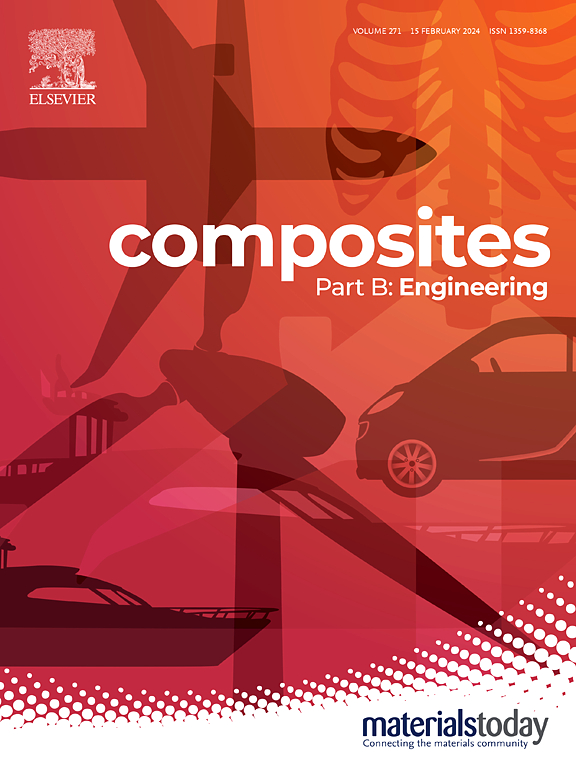多功能邻苯二腈气凝胶复合材料的制备、性能及应用前景
IF 12.7
1区 材料科学
Q1 ENGINEERING, MULTIDISCIPLINARY
引用次数: 0
摘要
多孔材料的设计和合成是推进邻苯二腈树脂多功能应用的关键策略。通过将杂环大分子结构固有的热机械稳定性与微孔和纳米孔结构赋予的功能优势相结合,这些材料提供了增强的高性能选择,以满足苛刻的使用条件。在此,我们提出了一种新的多步骤方法来制备纳米多孔邻苯二腈气凝胶复合材料(PNAC),包括邻苯二腈溶液配方、纤维增强剂浸渍、溶胶-凝胶反应、常压干燥和后固化。所得到的气凝胶基质具有由相互连接的纳米颗粒组成的三维多孔骨架。热分析显示出优异的稳定性,466°C的失重温度(Td5)为5%,1000°C的炭收率为55 wt%。针刺石英纤维毡的掺入大大提高了加工过程中的尺寸稳定性。制备的PNAC具有以下特性:低密度(0.28 g cm3)、超低导热系数(25℃时为54.3 mW·m−1·K−1);58.7 mW·m−1·K−1(200°C)),明显的疏水性(静态接触角:141°)和自熄行为。这种多功能配置文件使PNAC成为极端环境应用的有前途的候选者。本文章由计算机程序翻译,如有差异,请以英文原文为准。

Multifunctional phthalonitrile aerogel composites: preparation, performance and potential
The design and synthesis of porous materials represent a critical strategy for advancing multifunctional applications of phthalonitrile resins. By coupling the intrinsic thermomechanical stability derived from heterocyclic macromolecular architectures with the functional benefits imparted by micro- and nanoporous structures, these materials offer enhanced high-performance options to meet demanding service conditions. Herein, we present a novel multi-step methodology for fabricating nanoporous phthalonitrile aerogel composites (PNAC), comprising phthalonitrile solution formulation, fiber reinforcement impregnation, sol-gel reaction, ambient-pressure drying, and post-curing. The resulting aerogel matrix features a three-dimensional porous skeleton composed of interconnected nanoparticles. Thermal analysis reveals exceptional stability, with a 5 % weight loss temperature (Td5) of 466 °C and a char yield of 55 wt% at 1000 °C. Incorporation of needled quartz fiber felt significantly improves the dimensional stability during processing. The prepared PNAC demonstrates a unique combination of properties: low density (0.28 g cm3), ultralow thermal conductivity (54.3 mW·m−1·K−1 at 25 °C; 58.7 mW·m−1·K−1 at 200 °C), pronounced hydrophobicity (static contact angle: 141°), and self-extinguishing behavior. This multifunctional profile positions PNAC as a promising candidate for extreme-environmental applications.
求助全文
通过发布文献求助,成功后即可免费获取论文全文。
去求助
来源期刊

Composites Part B: Engineering
工程技术-材料科学:复合
CiteScore
24.40
自引率
11.50%
发文量
784
审稿时长
21 days
期刊介绍:
Composites Part B: Engineering is a journal that publishes impactful research of high quality on composite materials. This research is supported by fundamental mechanics and materials science and engineering approaches. The targeted research can cover a wide range of length scales, ranging from nano to micro and meso, and even to the full product and structure level. The journal specifically focuses on engineering applications that involve high performance composites. These applications can range from low volume and high cost to high volume and low cost composite development.
The main goal of the journal is to provide a platform for the prompt publication of original and high quality research. The emphasis is on design, development, modeling, validation, and manufacturing of engineering details and concepts. The journal welcomes both basic research papers and proposals for review articles. Authors are encouraged to address challenges across various application areas. These areas include, but are not limited to, aerospace, automotive, and other surface transportation. The journal also covers energy-related applications, with a focus on renewable energy. Other application areas include infrastructure, off-shore and maritime projects, health care technology, and recreational products.
 求助内容:
求助内容: 应助结果提醒方式:
应助结果提醒方式:


